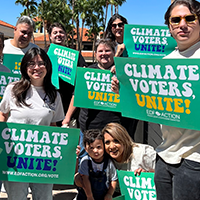Beyond Harvey and Irma: Congress to Begin Voting on Budgets That Could Weaken Disaster Preparedness and Hollow Out the EPA
EDF Action Releases List of Key Programs on the Chopping Block
Contact:
NEWS RELEASE
EDF Action today released a list of more than 15 key EPA initiatives (in an attached fact sheet) facing dangerous reductions or even elimination, efforts that help states and communities assess risks, clean up hazardous leaks, provide neighborhoods with information about threats, train emergency responders, and help low-income communities that often live near environmental hazards.
As Hurricane Irma bears down on the United States, Congress is getting ready to vote on whether to slash key Environmental Protection Agency (EPA) programs that help communities prepare for and respond to natural catastrophes, and that protect the health and safety of Americans year-round.
This spring, President Trump and EPA Administrator Scott Pruitt released a budget that would cut the EPA’s budget by 30 percent, to its lowest level since the 1970s.
“The EPA is already stretched thin after years of declining budgets,” said Elgie Holstein, EDF Action’s Senior Director for Strategic Planning. “Cutting the EPA budget would leave America more vulnerable to disaster, and threaten America’s environment, public health and economy for years to come.”
Last month, the Environmental Defense Fund released a series of reports, State of Risk, cataloguing the impact that EPA budget cuts would pose to citizens in 16 states: AZ, CA, CO, FL, IL, IN, MN, MT, NJ, NV, OH, PA, TN, VA, WI & WV. The reports are available at www.EDF.org/EPAcuts.
EDF Action experts are available to provide further context and comment about the EPA budget; please contact Ben Schneider, bschneider@edfaction.org, (202) 841-3763.
How Hobbling the EPA Would Threaten Disaster Preparedness and the Environment
Congress will soon begin critical votes on disaster recovery funding and the Trump Administration’s deep cuts to the Environmental Protection Agency’s annual budget.
The Environmental Protection Agency (EPA) helps communities prepare for and respond to natural catastrophes, just as it helps protect the health and safety of all Americans year-round. But the EPA is already stretched thin after years of declining budgets, and President Trump and EPA Administrator Pruitt are working to cut the EPA budget by 30 percent, which would also hobble many disaster response programs.
EPA Programs at Risk
Assessing Risks, Dealing with Contamination, and Supporting Cleanups
- A cut of almost 40% to EPA’s Homeland Security Efforts, including assessments of public health risks posed by major infrastructure and facilities.
- A 30% Cut to Superfund and Brownfield Programs that assess local chemical risks (including contamination of flooded neighborhoods), help return contaminated properties to job-creating productivity or as vital natural habitats, and hold polluters accountable.
- An 18% cut to EPA Superfund Emergency Response & Removal programs that help communities deal with chemical releases that threaten public health and the environment.
- A cut of nearly 30% to EPA Air Quality Monitoringprogramsto help communities warn residents when disasters and fires or other events year-round release hazardous chemicals into the air.
- A cut of 30% to EPA Public Water System supervision, which helps protect water quality during disasters and year-round from threats like raw sewage spills, fecal and other contamination in the water, and toxin-releasing algae blooms.
- A 48% Cut in EPA Underground Storage Tank/Leaking Underground Storage Tank Programs that help monitor underground storage tanks, detect leaks of petroleum or other hazardous products, repair damage to soil or ground-water, and hold polluters responsible.
- A 30% Cut to the EPA’s Underground Injection Control Program which protects drinking water supplies from underground disposal of chemicals from oil and gas operations.. More than half of people living in the US—and 99% of people living in rural areas—get their drinking water from groundwater supplies.
- Eliminate Nonpoint Source PollutionPrograms whichsupport state efforts to control pollutants carried by rainfall runoff into drinking water, rivers and lakes.
- A 40% cut to EPA Science and Technology Programs which pay for public health experts to assess damage to Superfund and other dangerous sites, plan cleanups, and hold responsible parties accountable.
- Cut 3,000 EPA career experts whose institutional knowledge and support are crucial in responding to environmental disasters and protecting the environment year-round.
Keeping Communities Informed and Helping to Deal With Chemical Releases
- A 35% Cut to State and Local Prevention and Preparedness Programs Dealing with Chemical Facility Safety that help prevent, prepare for, and respond to catastrophic accidental chemical releases at industrial facilities.
- The Trump Administration is also seeking to eliminate the U.S. Chemical Safety Board, an independent federal agency charged with investigating industrial chemical accidents.
- A 40% Cut in Community Right-to-Know/Toxics Release Inventory programsthatprovide neighborhoods near 20,000 industrial and federal facilities with information about pollutants and toxic substances being stored and released into their air, water, and soil. Such programs are critical for assessing risks at facilities like the volatile Arkema chemical plant in Crosby, TX.
- A 15% Cut in Oil Spill Prevention, Preparedness and Emergency programs that deal with leaks from above-ground storage tanks, pipelines and production facilities, and requires emergency planning for high risk oil storage facilities and refineries.
- Reduce EPA’s role in providing technical assistance and support to the U.S. Coast Guard for coastal and maritime oil spills.
Training & Supporting Local Emergency Responders
- Significantly scale back EPATraining & Technical Support for emergency responders working to protect their communities, tribes and other federal agencies from and chemical and oil spills.
Protect Low-Income Communities from Environmental Hazards
- Elimination of the EPA’S Office of Environmental Justice, the programs of which help low-income communities, which suffer disproportionately during natural disasters.



